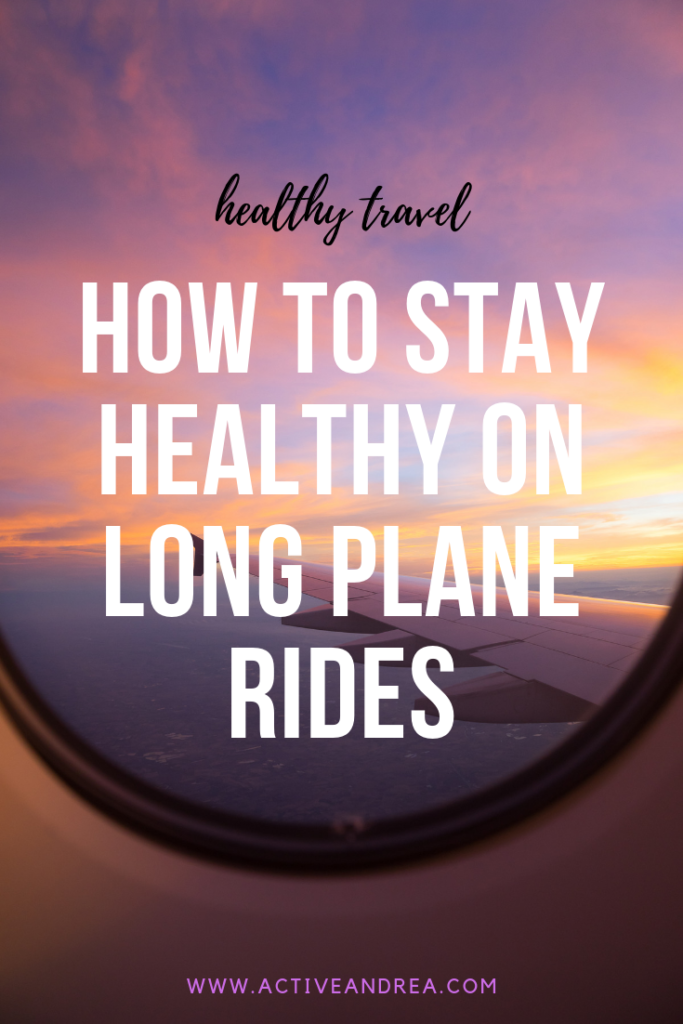Disclosure: This post may contain affiliate links, meaning I get a commission if you decide to make a purchase through my links, at no cost to you.
Recently, I flew back from Europe on a budget airline. During the 8-hour flight, I drank approximately 20 ounces of water and got up out of my cramped, limited-space seat once.
In the days following the flight, I felt like I was coming down with the flu. I was dehydrated, jet-lagged, and stiff. I ran the day after returning and seriously considered hitchhiking home midway through.

This article is basically a note to self so I don’t repeat the awfulness of that journey.
During your next flight, here are the health tips to follow so your body doesn’t hate you like mine did.
Drink water every hour
The lower humidity on planes (newer plane models have about a 25% humidity level, compared to most offices and homes being around 50% humidity) means your body dries out faster. Aim to drink 4 to 8 oz. of water every hour at a minimum to avoid massive dehydration.
I like to bring my own water bottle. Many flight attendants will usually fill up my entire bottle rather than giving me the tiny plastic cup.
Avoid alcohol
Alcohol dehydrates you quicker, so common sense says avoid alcohol when flying to preserve your hydration for longer.
However, I’m realistic. Many people drink while flying. If you end up getting your drink on (free drink coupons and bachelor[ette] parties are good excuses) then match every drink with at least 8 oz. of water.
Use the bathroom (or pretend) every hour
If you’re drinking the recommended 4 to 8 oz. of water per hour during your flight, you’ll probably have to use the bathroom. Getting up to go the bathroom is also a nice excuse to stretch your legs.
If you don’t have to use the bathroom, check it out anyway. Think of it as a nice quiet space to gather your thoughts and get away from your straightjacket of a seat. While you’re in there, stretch your arms above your head, lean side to side. No one will know.
Sit in the aisle so not to annoy seatmates about getting up every hour
No one wants the middle seat. Between the window and the aisle seat, I used to always choose the window. Having a view of the clouds and world below is wonderfully soothing, no?
But I have realized when I sit by the window, I am less likely to drink water in order to avoid using the bathroom. Purely because I’m the kind of person who hates asking my seatmates to get up for me.
If you’re the type of person who doesn’t mind asking people to do things for you, then, by all means, keep enjoying your window seat.
Otherwise, opt for the aisle seat. You can get up whenever you want and not annoy anyone! Plus, you can stretch your legs out into the aisle, which feels great. Just remember to keep your elbows tucked in when the food cart approaches. It tends to hit you right in the funny bone. That hurts.
Don’t eat
I’m pretty bad at this rule. In fact, I don’t think I’ve ever really followed it. But, according to experts, digestion can get wonky when your body soars at 35,000 feet above sea level.
Not eating helps lessen the effects of jetlag and avoid metabolism disruptions. On red-eye flights, it may help reset your circadian rhythm during the flight, as there is scientific evidence that suggests meal timing influences our biological clock.
At the high altitude, your digestive system will slow down or delay entirely, meaning those peanuts and pretzels could sit in your gut for hours until you land. Once you’re back on the ground and your digestive system wakes up, the extra work it needs to make up will make you more tired.
Soldiers from the CIA, Army, and Navy have been known to fast on long flights so they can hit the ground running when they land.
Fasting mostly helps for red-eye international flights when you’re changing time zones and landing at breakfast time. For shorter flights, fasting isn’t necessary unless you notice negative impacts to your digestion while eating on board.
If you must eat, eat food that agrees with you
In life, the motto “pack snacks,” rarely fails.
Plane food is often high in sodium, calories, and might not be the ideal food for your digestive system. The best snacks are solid foods that are easily packable, high in protein, and don’t make a mess.
Here are some ideas:
- Individual package of nut butter with a precut apple
- Unsalted mixed nuts
- Beef jerky
- Protein or granola bar
- Mozzarella cheese stick
Stretch while seated
My first experience with organized in-flight stretching was several years ago on a flight from Sri Lanka to China. It was just past dawn and I was delirious from lack of sleep. I remember waking up to the sound of music and the gentle tapping of feet.
I looked around and noticed all the passengers around me watching the plane television screens. They were following an instructional exercise video – spoken in Chinese – showing a woman in a plane seat doing simple movements and stretches.
Now more fully awake, I threw off my blanket and joined in the fun. Plane group exercise! What a beautiful concept.
I’ve still never been on American or European flight that had group stretching for its passengers, but you can be the cool weirdo doing it alone. Here are some basic stretches to do from your plane seat. (They also work great at the office.)
Shin Stretch
Flex your ankles up towards the ceiling. Slowly lower them to the floor until the feet are flat. Repeat 5 times.
Calf Stretch
Lift your heels up to the ceiling. Slowly lower them to the floor until the feet are flat. Repeat 5 times.
Ankle Stretch
Lift one foot off the ground. Roll the ankle 3 to 5 times clockwise before switch directions. Repeat on the opposite foot.
Neck Stretch
Slowly roll your head from side to side a couple of times. Then, lower your left ear towards your left shoulder. Hold for 3 to 5 seconds, taking slow inhales and exhales. Gently release and roll your head to your right shoulder. Repeat on the right side.
To make the stretch more intense, place the hand of the side you’re stretching gently on top of your head while you hold.
Shoulder Stretch
Bring your shoulders up towards your ears on an inhale. While you exhale, release them down the back, making your neck long. Repeat 3 to 5 times.
General Blood Circulation
Lift one thigh off the seat. Slowly lower it back down. Repeat 5 times on each leg.
Bring a Neck Pillow
On an international flight, a neck pillow can be the difference between comfort and discomfort, sleep and insomnia.
I forgot to bring a neck pillow on my most recent red-eye flight and sorely regretted it.
This neck pillow – with over 3,000 5-star reviews – supports your neck in multiple sitting positions.
In Summary
Flying coach on an international flight is rarely an enjoyable experience. But I guarantee if you follow these health tips for your next long flight, you’ll feel better than if you didn’t. Take care of your body and reach your destination ready to hit the ground running (in my case, literally).





This is awesome!
Once you use the aisle seats, there’s no going back. That’s the only way I find it possible to get up and use the washroom as an excuse to get in a quick stretch. 🤣
Keep up the great work!
Ha, yes I totally agree! Aisle seats make such a difference. Thanks Vinay!